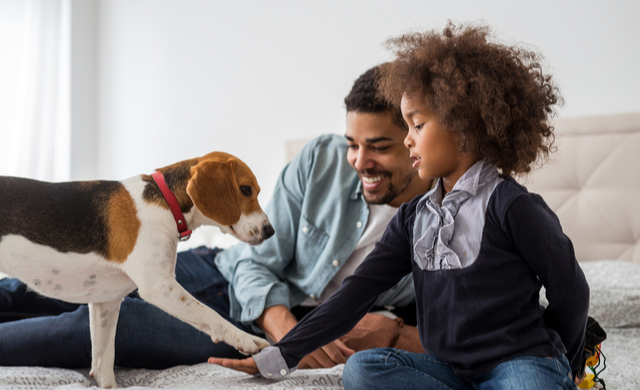
Life in lockdown: how to make children’s playtime with pets safe and enjoyable
05/16/2020 06:00AM | 3336 viewsby Nancy Gee
One of the most noticeable changes to daily life since the start of the COVID-19 pandemic has been social distancing. Both here in the US and around the world, the need to slow the spread of the virus has seen vast numbers of us living in lockdown and – as a result – spending many more hours at home.
If, like me, you’re one of the 60% of US households that includes a companion animal[i], this probably means being able to enjoy more time with your pet(s) than usual too. And for those of us with children, the heart-warming experience of watching your kids and pets play together has no doubt provided a small silver lining in an otherwise strange and unsettling time for everyone.
As a long-time pet owner, I know all about the personal enjoyment I get from time spent with my pets. But as a scientist, I’ve been also fortunate to be involved in several studies looking into the importance of human-animal interactions, including those involving children. And though the reason for our enforced lockdown is overwhelmingly negative, I can confirm that science suggests the increased interaction between our kids and our pets is likely to also be having a positive effect.
Indeed, there is mounting evidence – empirical and anecdotal – to suggest that regular exposure to pets and companion animals can benefit children’s physiological, cognitive and socio-emotional development[ii]. For example, children who live with cats have been shown to experience a relaxation in heart rate or “calming effect” after interacting with them, while having a pet dog in the home has been associated with a reduced risk of childhood anxiety – something that could be especially important given the extraordinary and stressful nature of life at the moment. One study even found that adolescents report greater satisfaction in their relationships with pets than with siblings.
These kinds of findings, along with countless accounts from parents, teachers and the medical community, serve to underline the physical and psychological benefits of the child-animal bond.
But there is a note of caution here too. A 2008 report examined the incidence of dog bites and, though the number involving children was lower than among adults, young people were more likely to require hospital treatment as a result. And the most common source of bites? The family dog.
In many cases, these incidents arise from interactions that humans perceive as benign. Parents of children bitten by a pet often express surprise at something that ‘seemed to come from nowhere’ yet these statements tend to reflect a misunderstanding of the behaviors that can indicate stress and discomfort in animals. It is important to ensure a safe and comfortable environment for pets and children to engage in with appropriate oversight from parents and caregivers.
Understanding a pet’s behaviour can be challenging for children, particularly the very young. For example, a study into how kids and parents interpret dogs’ body language found that while adults commit few errors in identifying angry dog faces, four to six year olds frequently make the mistake of confusing a dog baring its teeth and snarling with the happy, smiling expression of a friendly animal.
Organizations like The Blue Dog are doing some fantastic work in addressing these knowledge gaps and are a great source of advice for parents and kids alike. I encourage you all to learn more about how they’re working to reduce dog bites among children.
In the meantime, here are my top five tips for ensuring your children and pets stay as safe and happy together as possible, especially during life under lockdown.
- Since a pet’s fur is like any other surface, thorough handwashing for children after interacting with pets is important. Make sure an adult is present to supervise children, especially those under the age of 5, washing their hands.
- There is no substitute for parental oversight, so make sure there is an adult who can supervise interactions between kids and pets. You are likely to spot and act upon any warning signs far quicker than your kids.
- Learn the signs your dog is stressed so you can give them some space and avoid a conflict. Yawning, licking lips, or avoiding eye contact can be the first signs a dog gives that they are uncomfortable. When a dog feels threatened, they will also not take their eyes off the threat, maintaining intense and direct eye contact. A low growl or rigid body can also be warning signs your animal is in distress.
- Although children can learn animal stress signals, they need frequent reminders. So, keep talking to them about how to recognize when a pet is anxious or uncomfortable by reading its body language.
- It is not just our own routines that have been disrupted by the coronavirus; so have our pets’. More people, more noise and more action in the home can be unsettling for them, so make sure there is time and space each day for animals to get away from it all and rest.
At a time when life is anything but normal, family pets can be an incredible source of comfort and relief. A chance for us all to forget the stresses and strains of life with COVID-19 and get back to the familiar pleasure of spending time with animals in our home.
But with great fun also comes great responsibility. As adults, it’s up to us to ensure this extra time together is spent safely, positively and enjoyably – by all concerned.
[i] DeLoache JS, Pickard MB, LoBue V. How very young children think about animals. In: McCardle P, McCune,S, Griffin J, et al. (eds.) How Animals Affect Us. Washington DC: American Psychological Association, 2011;85-100.
[ii] Gee, N.R., (In Press). The Child-Animal Bond. Veterinary Focus, 30.2, June 2020.
***
This article was originally posted on LinkedIn: https://www.linkedin.com/pulse/life-lockdown-how-make-childrens-playtime-pets-safe-enjoyable-gee/

Nancy Gee is a Professor of Psychiatry & Director of the Center for Human-AnimalInteraction at Virginia Commonwealth University School of Medicine.










Post your Comment
Please login or sign up to comment
Comments